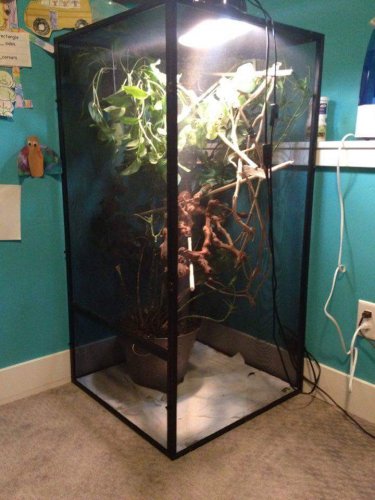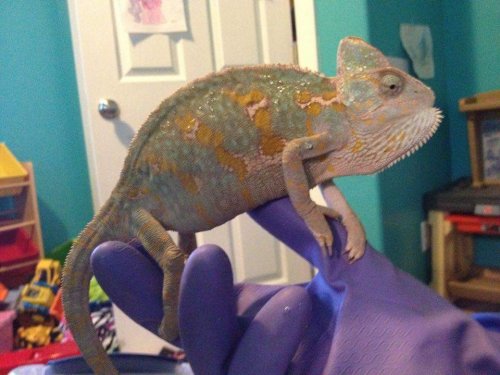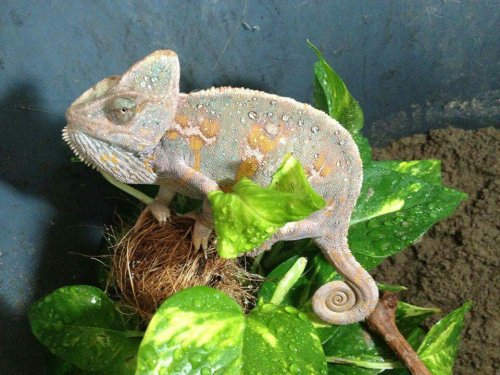Kavet83
New Member
I'm new here and have been scouring the threads looking for help. We have had our females veiled, Izzy, for 3-4 months. Previous owners had her for a few months. And she came from a breeder who got at least one clutch of fertile eggs from her. So I don't entirely know her age.
She's in a 2'x2'x4' screened cage. Those I got her from gave me super worms to feed her, no supplements. No laying bin or talk of egg laying when they told me she was easy to take care of. I researched a bunch after we got her and changed some things in her cage and got her a bin of damp sand to know if she needed to lay eggs.
Last week she wouldn't eat when offered her container with a worm. She ate a little if I left a worm in Container in her cage. On Sunday she dug in her sand bin. So we got a giant trash can set up for egg laying. Unfortunately I didn't quite have enough sand to make it a foot deep but it's maybe 6-8 inches I think. We put her new plant in and a log/stick from her cage. I made a starter hole for her. It was evening when we got it set up for her. We left her overnight, she slept on the log. Started digging in my hole in the morning. Dug all day until about 6 when she went in tail first and hopefully laid her eggs. About 10 or 10:30 she started to push sand back into the hole very slowly.
I have been so worried about her this whole time. Everything I read said leave her alone so I haven't misted and worried about that. We have a webcam over her so we can watch the process. I didn't know if we should leave lights on to help her finish or not and finally found the answer and turned her lights off overnight. She slept in the hole. I hoped she would be done this morning but she is still burying the eggs. Slowly. I'm worried she's too tired. Just recently she turned back around in the hole. Is it best to wait until she finishes covering the hole and returns to her branches before I take her back to her cage? Or should I take her out now and hydrate and feed her? How long does covering the hole usually take? Does it matter if she sees me at this point since she should be done laying the eggs? Sorry for all the questions. I just feel like a bad mom. She hasn't been getting calcium so I worry about that. I have it now for the future but I know egg laying takes a lot out of them.
She's in a 2'x2'x4' screened cage. Those I got her from gave me super worms to feed her, no supplements. No laying bin or talk of egg laying when they told me she was easy to take care of. I researched a bunch after we got her and changed some things in her cage and got her a bin of damp sand to know if she needed to lay eggs.
Last week she wouldn't eat when offered her container with a worm. She ate a little if I left a worm in Container in her cage. On Sunday she dug in her sand bin. So we got a giant trash can set up for egg laying. Unfortunately I didn't quite have enough sand to make it a foot deep but it's maybe 6-8 inches I think. We put her new plant in and a log/stick from her cage. I made a starter hole for her. It was evening when we got it set up for her. We left her overnight, she slept on the log. Started digging in my hole in the morning. Dug all day until about 6 when she went in tail first and hopefully laid her eggs. About 10 or 10:30 she started to push sand back into the hole very slowly.
I have been so worried about her this whole time. Everything I read said leave her alone so I haven't misted and worried about that. We have a webcam over her so we can watch the process. I didn't know if we should leave lights on to help her finish or not and finally found the answer and turned her lights off overnight. She slept in the hole. I hoped she would be done this morning but she is still burying the eggs. Slowly. I'm worried she's too tired. Just recently she turned back around in the hole. Is it best to wait until she finishes covering the hole and returns to her branches before I take her back to her cage? Or should I take her out now and hydrate and feed her? How long does covering the hole usually take? Does it matter if she sees me at this point since she should be done laying the eggs? Sorry for all the questions. I just feel like a bad mom. She hasn't been getting calcium so I worry about that. I have it now for the future but I know egg laying takes a lot out of them.




